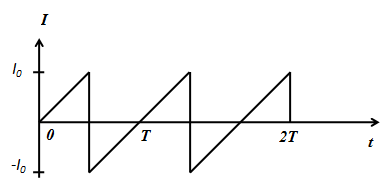
For the circuit shown in figure the rms current is

A. \[{I_0}\]
B. \[{I_0}/\sqrt 2 \]
C. \[{I_0}/\sqrt 3 \]
D. \[{I_0}/2\]

Answer
561.6k+ views
Hint: Identify the current I function in the region of \[0 < t < \dfrac{T}{2}\] and \[\dfrac{T}{2} < t < T\]. First, we will find the square of the current function and integrate over the region. After that, we can take the square root of obtained value and that will be rms value.
Complete step by step answer:
The rms is an abbreviation of root mean square value of a function. In order to do so, first we have to square the function then find its mean value and then at last square root of that value.
From the figure, we know the form of the current (\[I\]) function.
\[I = \dfrac{{2{I_0}}}{T}t\] for \[0 < t < \dfrac{T}{2}\]
And,
\[I = \dfrac{{2{I_0}}}{T}\left( {t - T} \right)\] for \[\dfrac{T}{2} < t < T\]
Since it is a period function in nature, we do not need to account the whole region. We will calculate the mean square speed in one time period T.
We take the square of the above equation as follows,
\[{I^2} = \dfrac{{4I_0^2}}{{{T^2}}}{t^2}\] for \[0 < t < \dfrac{T}{2}\]
And,
\[{I^2} = \dfrac{{4I_0^2}}{{{T^2}}}{\left( {t - T} \right)^2}\] for \[\dfrac{T}{2} < t < T\]
The mean of this function will be,
\[I_{mean}^2 = \int\limits_0^T {{I^2}} dt = \int\limits_0^{\dfrac{T}{2}} {{I^2}} dt + \int\limits_{\dfrac{T}{2}}^T {{I^2}} dt\]
\[ \Rightarrow I_{mean}^2 = \int\limits_0^{\dfrac{T}{2}} {\dfrac{{4I_0^2}}{{{T^2}}}{t^2}} dt + \int\limits_{\dfrac{T}{2}}^T {\dfrac{{4I_0^2}}{{{T^2}}}{{\left( {t - T} \right)}^2}} dt\]
\[ \Rightarrow I_{mean}^2 = \int\limits_0^{\dfrac{T}{2}} {\dfrac{{4I_0^2}}{{{T^2}}}{t^2}} dt + \int\limits_{\dfrac{T}{2}}^T {\dfrac{{4I_0^2}}{{{T^2}}}\left( {{t^2} - 2tT + {T^2}} \right)} dt\]
\[ \Rightarrow I_{mean}^2 = \dfrac{{4I_0^2}}{{{T^2}}}\left( {\left( {\dfrac{{{t^3}}}{3}} \right)_0^{\dfrac{T}{2}} + \left( {\dfrac{{{t^3}}}{3}} \right)_{\dfrac{T}{2}}^T - 2T\left( {\dfrac{{{t^2}}}{2}} \right)_{\dfrac{T}{2}}^T + {T^2}\left( t \right)_{\dfrac{T}{2}}^T} \right)\]
After simplifying the above equation further we get,
\[I_{mean}^2 = \dfrac{{4I_0^2}}{{{T^2}}}\left( {\dfrac{{{T^2}}}{{12}}} \right)\]
\[ \Rightarrow I_{mean}^2 = \dfrac{{I_0^2}}{3}\]
Now, root mean square of the current function will be,
\[{I_{rms}} = \sqrt {I_{mean}^2} = \sqrt {\dfrac{{I_0^2}}{3}} \]
\[ \Rightarrow {I_{rms}} = \dfrac{{{I_0}}}{{\sqrt 3 }}\]
So, the current answer is option (C).
Note:
In case of an odd periodic function, the mean value of the function in one time period goes to zero. To understand the mean nature of the corresponding function, root mean square value is very important for odd periodic functions. By using the Fourier series identity we could have write the equation \[\int\limits_0^{\dfrac{T}{2}} {{I^2}} dt + \int\limits_{\dfrac{T}{2}}^T {{I^2}} dt = 2\int\limits_0^T {{I^2}} dt\] if the function is symmetric. But the function has different values in the respective regions, we cannot do so.
Complete step by step answer:
The rms is an abbreviation of root mean square value of a function. In order to do so, first we have to square the function then find its mean value and then at last square root of that value.
From the figure, we know the form of the current (\[I\]) function.
\[I = \dfrac{{2{I_0}}}{T}t\] for \[0 < t < \dfrac{T}{2}\]
And,
\[I = \dfrac{{2{I_0}}}{T}\left( {t - T} \right)\] for \[\dfrac{T}{2} < t < T\]
Since it is a period function in nature, we do not need to account the whole region. We will calculate the mean square speed in one time period T.
We take the square of the above equation as follows,
\[{I^2} = \dfrac{{4I_0^2}}{{{T^2}}}{t^2}\] for \[0 < t < \dfrac{T}{2}\]
And,
\[{I^2} = \dfrac{{4I_0^2}}{{{T^2}}}{\left( {t - T} \right)^2}\] for \[\dfrac{T}{2} < t < T\]
The mean of this function will be,
\[I_{mean}^2 = \int\limits_0^T {{I^2}} dt = \int\limits_0^{\dfrac{T}{2}} {{I^2}} dt + \int\limits_{\dfrac{T}{2}}^T {{I^2}} dt\]
\[ \Rightarrow I_{mean}^2 = \int\limits_0^{\dfrac{T}{2}} {\dfrac{{4I_0^2}}{{{T^2}}}{t^2}} dt + \int\limits_{\dfrac{T}{2}}^T {\dfrac{{4I_0^2}}{{{T^2}}}{{\left( {t - T} \right)}^2}} dt\]
\[ \Rightarrow I_{mean}^2 = \int\limits_0^{\dfrac{T}{2}} {\dfrac{{4I_0^2}}{{{T^2}}}{t^2}} dt + \int\limits_{\dfrac{T}{2}}^T {\dfrac{{4I_0^2}}{{{T^2}}}\left( {{t^2} - 2tT + {T^2}} \right)} dt\]
\[ \Rightarrow I_{mean}^2 = \dfrac{{4I_0^2}}{{{T^2}}}\left( {\left( {\dfrac{{{t^3}}}{3}} \right)_0^{\dfrac{T}{2}} + \left( {\dfrac{{{t^3}}}{3}} \right)_{\dfrac{T}{2}}^T - 2T\left( {\dfrac{{{t^2}}}{2}} \right)_{\dfrac{T}{2}}^T + {T^2}\left( t \right)_{\dfrac{T}{2}}^T} \right)\]
After simplifying the above equation further we get,
\[I_{mean}^2 = \dfrac{{4I_0^2}}{{{T^2}}}\left( {\dfrac{{{T^2}}}{{12}}} \right)\]
\[ \Rightarrow I_{mean}^2 = \dfrac{{I_0^2}}{3}\]
Now, root mean square of the current function will be,
\[{I_{rms}} = \sqrt {I_{mean}^2} = \sqrt {\dfrac{{I_0^2}}{3}} \]
\[ \Rightarrow {I_{rms}} = \dfrac{{{I_0}}}{{\sqrt 3 }}\]
So, the current answer is option (C).
Note:
In case of an odd periodic function, the mean value of the function in one time period goes to zero. To understand the mean nature of the corresponding function, root mean square value is very important for odd periodic functions. By using the Fourier series identity we could have write the equation \[\int\limits_0^{\dfrac{T}{2}} {{I^2}} dt + \int\limits_{\dfrac{T}{2}}^T {{I^2}} dt = 2\int\limits_0^T {{I^2}} dt\] if the function is symmetric. But the function has different values in the respective regions, we cannot do so.
Recently Updated Pages
Master Class 12 Business Studies: Engaging Questions & Answers for Success

Master Class 12 Social Science: Engaging Questions & Answers for Success

Master Class 12 English: Engaging Questions & Answers for Success

Master Class 12 Chemistry: Engaging Questions & Answers for Success

Class 12 Question and Answer - Your Ultimate Solutions Guide

Master Class 12 Economics: Engaging Questions & Answers for Success

Trending doubts
What are the major means of transport Explain each class 12 social science CBSE

Which are the Top 10 Largest Countries of the World?

Draw a labelled sketch of the human eye class 12 physics CBSE

How much time does it take to bleed after eating p class 12 biology CBSE

Explain sex determination in humans with line diag class 12 biology CBSE

Differentiate between homogeneous and heterogeneous class 12 chemistry CBSE




